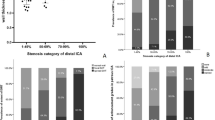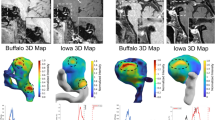Abstract
Purpose
The purpose of this study was to evaluate whether cerebral perfusion from bypassed arteries can be demonstrated on regional perfusion imaging (RPI) using arterial spin labeling. We then compared cerebral perfusion on RPI and digital subtraction angiography (DSA) in moyamoya patients who underwent extracranial-intracranial bypass surgery.
Materials and methods
We performed RPI using a 3-T magnetic resonance scanner and DSA studies in 11 moyamoya patients treated by bypass surgery. For RPI we placed a selective labeling slab on the bypassed external carotid artery. Two neuroradiologists determined the extent and location of the cerebral perfusion from bypass arteries in the middle cerebral artery territories on RPI and DSA. Kappa analysis was used to assess the interobserver agreement with respect to the extent and location of the cerebral perfusion and to evaluate the intermodality agreement between RPI and DSA.
Results
Interobserver agreement for the extent of cerebral perfusion on RPI was very good (kappa = 0.89), with excellent location (kappa = 1.00). Intermodality agreement for the extent of perfusion was very good (kappa = 0.89), with good location (kappa = 0.74).
Conclusion
RPI is useful for evaluating cerebral perfusion from bypass arteries in moyamoya patients.
Similar content being viewed by others
References
Suzuki J, Takaku A. Cerebrovascular “moyamoya” disease: disease showing abnormal net-like vessels in base of brain. Arch Neurol 1996;20:288–299.
Suzuki J, Kodama N. Moyamoya disease: a review. Stroke 1983;14:104–109.
Reis CV, Safavi-Abbasi S, Zabramski JM, Gusmao SN, Spetzler RF, Preul MC. The history of neurosurgical procedures for moyamoya disease. Neurosurg Focus 2006;20:E7.
Kuroda S, Houkin K. Moyamoya disease: current concepts and future perspectives. Lancet Neurol 2008;7:1056–1066.
Togao O, Mihara F, Yoshiura T, Tanaka A, Noguchi T, Kuwabara Y, et al. Cerebral hemodynamics in moyamoya disease: correlation between perfusion-weighted MR imaging and cerebral angiography. AJNR Am J Neuroradiol 2006;27:391–397.
Calamante F, Ganesan V, Kirkham FJ, Jan W, Chong WK, Gadian DG, et al. MR perfusion imaging in moyamoya syndrome: potential implications for clinical evaluation of occlusive cerebrovascular disease. Stroke 2001;32:2810–2816.
Siewert B, Schlaugh G, Edelman RR, Warach S. Comparison of EPISTAR and T2-weighted gadolinium-enhanced perfusion imaging in patients with acute cerebral ischemia. Neurology 1997;48:673–679.
Chalela JA, Alsop DC, Gonzalez-Atavales JB, Maldjian JA, Kasner SE, Detre JA. Magnetic resonance perfusion imaging in acute ischemic stroke using continuous arterial spin labeling. Stroke 2000;31:680–687.
Detre JA, Alsop DC. Perfusion magnetic resonance imaging with continuous arterial spin labeling: methods and clinical applications in the central nervous system. Eur J Radiol 1999;30:115–124.
Van Laar PJ, van der Grond J, Hendrikse J. Brain perfusion territory imaging: methods and clinical applications of selective arterial spin-labeling MR imaging. Radiology 2008;246:354–364.
Hendrikse J, van der Grond J, Lu H, van Zijl PC, Golay X. Flow territory mapping of the cerebral arteries with regional perfusion MRI. Stroke 2004;35:882–887.
Golay X, Petersen ET, Hui F. Pulsed star labeling of arterial regions (PULSAR): a robust regional perfusion technique for high field imaging. Magn Reson Med 2005;53:15–21.
Wong EC. Vessel-encoded arterial spin-labeling using pseudo-continuous tagging. Magn Reson Med 2007;58:1086–1091.
Chng SM, Petersen ET, Zimine I, Sitho YY, Lim CC, Golay X. Territorial arterial spin labeling in the assessment of collateral circulation: comparison with digital subtraction angiography. Stroke 2008;39:3248–3254.
Van Laar PJ, van der Grond J, Bremmer JP, Klijn CJ, Hendrikse J. Assessment of the contribution of the external carotid artery occlusion. Stroke 2008;39:3003–3008.
Pruessmann KP, Golay X, Stuber M, Scheidegger MB, Boesiger P. RF pulse concatenation for spatially selective inversion. J Magn Reson 2000;146:58–65.
Osborn AG. Normal vascular anatomy. In: Osborn AG, editor. Diagnostic neuroradiology. 1st edn. St. Louis: Mosby; 1994. p. 117–153.
Osborn AG. The middle cerebral artery: normal gross and angiographic anatomy of the craniocervical vasculature. In: Osborn AG, editor. Diagnostic cerebral angiography. 2nd edn. Philadelphia: Lippincott; 1999. p. 135–172.
Yongbi MN, Fera F, Yang Y, Frank JA, Duyn JH. Pulsed arterial spin labeling: comparison of multisection baseline and functional MR perfusion signal at 1.5 and 3.0 T: initial results in six subjects. Radiology 2002;222:569–575.
Franke C, van Dorsten FA, Olah L, Schwindt W, Hoehn M. Arterial spin tagging perfusion imaging of rat brain: dependency on magnetic field strength. Magn Reson Imaging 2000;18:1109–1113.
Golay X, Petersen ET. Arterial spin labeling: benefits and pitfalls of high magnetic field. Neuroimaging Clin N Am 2006;16:259–268.
Liebeskind DS. Collateral circulation. Stroke 2003;34:2279–2284.
Gibbs JM, Wise RJ, Leenders KL, Jones T. Evaluation of cerebral perfusion reserve in patients with carotid-artery occlusion. Lancet 1984;1:310–314.
Matsushima T, Fukui M, Kitamura K, Hasuo K, Kuwabara Y, Kurokawa T. Encephalo-duro-arterio-synangiosis in children with moyamoya disease. Acta Neurochir (Wien) 1990;104:96–102.
Nochide I, Ohta S, Ueda T, Shiraishi M, Watanaba H, Sasaki S, et al. Evaluation of cerebral perfusion from bypass arteries using selective intraarterial microsphere tracer after vascular reconstructive surgery. AJNR Am J Neuroradiol 1998;19:1669–1676.
Hendrikse J, van der Zwan A, Ramos LM. Altered flow territories after extracranial-intracranial bypass surgery. Neurosurgery 2005;57:486–494.
Author information
Authors and Affiliations
Corresponding author
About this article
Cite this article
Kitajima, M., Hirai, T., Shigematsu, Y. et al. Assessment of cerebral perfusion from bypass arteries using magnetic resonance regional perfusion imaging in patients with moyamoya disease. Jpn J Radiol 28, 746–753 (2010). https://doi.org/10.1007/s11604-010-0507-0
Received:
Accepted:
Published:
Issue Date:
DOI: https://doi.org/10.1007/s11604-010-0507-0




